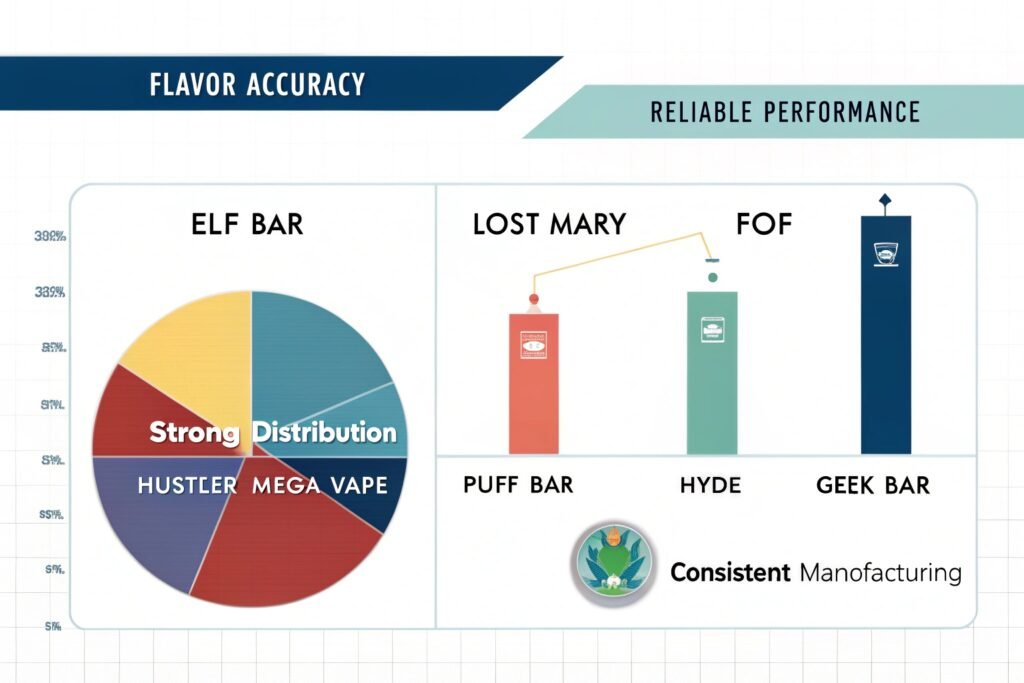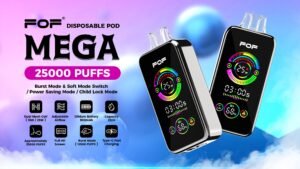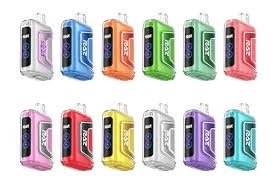Wondering if all those colorful disposable vapes are just the same device in different packaging? After a decade in vape manufacturing, I've seen how dramatically these seemingly simple devices can differ beneath their plastic shells.
No, disposable e-cigarette pens vary significantly in design. While they share basic components (battery, e-liquid reservoir, coil, and mouthpiece), they differ in battery capacity, airflow systems, heating technology, e-liquid volume, and internal architecture, all affecting performance, flavor delivery, and lifespan.
 Variety of Disposable Vape Designs
Variety of Disposable Vape Designs
As someone who's worked my way up from the factory floor to running my own vape manufacturing company, I've gained unique insights into what makes disposable vapes truly different. Working with distributors like Tommy, who demands exceptional quality for his Malaysian market, I've learned that design differences aren't just marketing gimmicks – they fundamentally affect user satisfaction. Let me take you behind the scenes to understand what really separates one disposable vape from another.
Are All Vape Pens the Same?
Confused about whether that premium-priced vape pen offers anything better than a budget option? Wondering if the differences are just clever marketing or genuinely meaningful? Let's unpack what makes vape pens distinct from each other.
No, vape pens differ significantly in design philosophy, component quality, and engineering. Key differences include battery technology (280-850mAh), coil materials (kanthal, mesh, ceramic), airflow systems (tight or airy), e-liquid capacity (1.2-14ml), and power delivery methods, all creating noticeably different user experiences.
 Vape Pen Component Comparison
Vape Pen Component Comparison
When I first started manufacturing vape products, I was surprised by how many engineering decisions go into creating even a simple vape pen. Every component presents choices that affect the final experience:
Battery Technology Variations
Battery design is probably the most significant differentiator in vape pens:
- Capacity range: From small 280mAh batteries in mini disposables to 850mAh+ in larger devices
- Battery chemistry[1]: Different lithium-ion formulations affect performance in hot/cold conditions
- Power delivery curve[2]: Some batteries maintain consistent power until depleted while others gradually fade
- Safety circuitry[3]: Quality varies significantly in overcharge protection, thermal regulation, and short-circuit prevention
In our factory, we test batteries extensively because they're both the heart of the device and the main potential failure point. When Tommy visits to check our manufacturing processes, he's always particularly focused on battery quality because it affects both safety and user satisfaction.
Heating Element Design
The heating element (coil) creates surprising variance in performance:
- Material options: Traditional wire coils, mesh designs, ceramic elements
- Resistance levels: Affecting vapor temperature and battery efficiency
- Wicking materials: Cotton, silica, ceramic, or proprietary materials
- Coil placement: Position relative to airflow affects flavor intensity and throat hit
I remember one project where we tested eight different coil designs before finding one that perfectly balanced battery life with flavor production. These small engineering choices make a big difference in the final product.
Airflow Engineering
Airflow design significantly impacts user satisfaction:
- Draw resistance: Tight cigarette-like draws vs. airier direct-lung experiences
- Air channel positioning: Side, bottom, or top airflow creating different flavor profiles
- Adjustable vs. fixed airflow: Some devices allow customization while others are optimized for one experience
- Air inlet size: Affecting both draw feel and vapor temperature
The airflow system might seem simple, but it's actually one of the most complex aspects of vape design. We've spent countless hours in R&D adjusting air channel diameters by fractions of a millimeter to achieve the perfect draw.
E-Liquid Delivery Systems
How e-liquid reaches the coil varies across different designs:
- Direct wicking systems[4]: Where the coil draws directly from the reservoir
- Capillary systems[5]: Using various materials to transport e-liquid to the coil
- Pressure-equalized systems[6]: More sophisticated designs that prevent leaking and flooding
These differences directly affect consistency of flavor delivery, leak resistance, and how well the device handles different vaping frequencies.
Through my years in manufacturing, I've learned that these engineering differences aren't just technical details – they translate directly to user satisfaction, reliability, and value for money.
Are Disposable Vapes the Same?
Ever wondered if there's any real difference between the countless disposable vapes flooding the market? Confused about why some cost twice as much as others? Here's the inside story on what truly separates these devices.
No, disposable vapes differ substantially despite similar appearances. They vary in battery quality and capacity (280-1000mAh), e-liquid formulation and volume (1.2-14ml), coil design (traditional, mesh, or ceramic), automation level in manufacturing, and quality control standards, creating significant performance differences.
 Disposable Vape Internal Components
Disposable Vape Internal Components
Having overseen the production of millions of disposable vapes, I've seen firsthand how dramatically they can differ beneath similar exteriors. These differences affect everything from initial flavor quality to how consistently they perform over their lifespan:
Manufacturing Process Differences
Not all disposable vapes are made the same way:
- Automation level: Fully automated production lines vs. semi-automated assembly with manual quality checks
- Component testing: Some factories test each battery individually while others only sample test
- Assembly precision: Affecting coil positioning, connection quality, and leak potential
- Clean room standards: Higher-end products are assembled in controlled environments
When vape distributors first visited our factory, he was particularly impressed by our automated testing stations[^7] that check each device before packaging. This level of quality assurance[^8] isn't universal – some manufacturers rely solely on random batch testing, leading to more inconsistent products.
E-Liquid Quality Variations
The liquid inside makes a major difference:
- Base ingredient quality: Pharmaceutical vs. industrial grade ingredients
- Nicotine purity: Higher-grade nicotine provides smoother throat hit
- Flavor complexity: Some brands use simple single-note flavors while others develop complex profiles
- Consistency control: Methods to ensure flavor consistency across production batches
We work with specialized flavor houses to create custom profiles for our premium lines. This investment in quality ingredients and development time directly translates to a better taste experience but also increases production costs.
Size and Capacity Range
The market has evolved to include several distinct categories:
- Mini disposables: 1.2-2ml capacity, 280-350mAh batteries, typically 400-600 puffs
- Standard disposables: 2-4ml capacity, 350-550mAh batteries, typically 600-1500 puffs
- Extended-use disposables: 5-14ml capacity, 550-1000mAh+ batteries, typically 2000-7000+ puffs
These categories represent genuine differences in component sizing and materials used. The engineering challenges for a 7000-puff device are completely different from those of a 500-puff device.
Long-term Performance Engineering
How well disposables maintain performance until the end varies dramatically:
- Power regulation: Better devices maintain consistent power output as battery depletes
- Wicking efficiency: Quality devices continue to wick properly as e-liquid level decreases
- Coil longevity: Some coils maintain flavor quality longer than others
Early in my manufacturing career, I learned that creating a device that performs well on the first day is relatively easy – the challenge is engineering one that works just as well on day 7 or day 14. Premium brands invest significantly in solving these long-term performance challenges.
When I consult with distributors like Tommy, I emphasize that these "invisible" engineering differences often matter more than the obvious external design features. They're why some brands build loyal customer bases while others see high trial but low repeat purchase rates.
What Is the Most Popular Disposable E-Cigarette?
Wondering which disposable vapes have earned the largest market share? Curious about what makes certain brands rise above the competition? Here's the current state of the market based on my industry perspective.
The most popular disposable e-cigarettes globally include Elf Bar/Lost Mary, FOF,Hustler Mega Vape,Puff Bar, Hyde, and Geek Bar, with regional variations. These market leaders have gained dominance through exceptional flavor accuracy, reliable performance, strong distribution networks, and manufacturing consistency.
 Top Disposable Vape Brands by Market Share
Top Disposable Vape Brands by Market Share
Through my network of distribution partners across multiple continents, including Tommy's operations in Malaysia, I've watched market trends evolve rapidly. While popularity varies by region, certain patterns and leaders have emerged:
Current Global Market Leaders
As of my most recent market analysis:
- North America: Elf Bar/Lost Mary[^9],FOF Vape[^10],Hustler Mega Vape,Puff Bar, Hyde, and JUUL (in markets where available)
- Europe: Elf Bar/Lost Mary, Geek Bar[^11], IVG, and Dinner Lady
- Asia-Pacific: RELX, FOF Vape,MOTI, Geek Bar, and various regional brands
- Middle East: VGOD StigX, KROS, and Elf Bar have strong presence
These rankings shift quarterly with new product introductions and regulatory changes, but these brands have shown staying power through multiple product generations.
What Makes Winning Brands Successful
The most successful disposable brands share several key characteristics:
- Flavor accuracy and consistency: Market leaders create flavors that genuinely match their descriptions and maintain that profile through the entire lifespan of the device
- Leak resistance: The best-selling brands have engineered reliable solutions to the leaking problems that plague lower-quality disposables
- Battery life matching e-liquid capacity: Ensuring the battery doesn't die before the e-liquid is consumed
- Quality control consistency: Leading brands maintain strict standards even when scaling production
When the Vape distributers and I discuss market trends during his factory visits, we often analyze successful competitors' products to understand what's driving their popularity. It's rarely a single feature but rather the consistent execution across all aspects of the product.
Regional Market Variations
Working with international distributors has shown me how preferences vary significantly:
- Flavor preferences: In Asia, fruit and beverage flavors dominate, while North America sees stronger demand for dessert profiles and menthol
- Device size preference: European markets favor slimmer, more discrete devices, while some other markets embrace larger devices with longer life
- Nicotine strength demand: Markets with stricter regulations (EU at 20mg/ml max) develop different preferences than less restricted markets
Understanding these regional variations has been crucial for helping clients like Hustler Mega Vape select the right products for their specific markets. A best-seller in one region often performs poorly in another due to these preference differences.
Through my manufacturing experience, I've learned that market leadership is earned through consistency and reliability rather than just marketing hype or novel features. The brands that maintain quality as they scale production are the ones that build lasting market share.
Why Are Disposable Vapes So Expensive?
Shocked by the price tag on disposable vapes? Wondering how a single-use device can cost so much? As a manufacturer, let me break down what really drives those prices and where your money goes.
Disposable vapes are expensive due to combined costs of integrated components (battery, atomizer, e-liquid), convenience premium, distribution chain markups (sometimes 200-300%), regulatory compliance expenses, marketing costs, and import duties/taxes. Manufacturing costs typically represent only 20-30% of final retail prices.
 "Disposable Vape Price Breakdown"
"Disposable Vape Price Breakdown"
Having manufactured millions of disposable vapes and seen the complete cost structure from factory to retail shelf, I can provide unique insight into why these seemingly simple devices carry surprisingly high price tags:
The True Manufacturing Cost Structure
The actual production costs include:
- Battery: $0.80-2.50 depending on capacity and quality
- Integrated circuit/control board: $0.30-1.20
- Atomizer/coil assembly: $0.40-1.50
- E-liquid: $0.30-1.20 depending on volume and quality
- Housing/external components: $0.40-1.00
- Assembly and quality control: $0.50-1.50
- Packaging: $0.20-0.50
This puts the actual manufacturing cost of a typical disposable between $2.90-9.40, with premium features and larger capacities at the higher end. Yet these same devices often retail for $10-25, representing a significant markup.
Distribution Chain Markups
One of the biggest factors in disposable vape pricing[^12] is the distribution path:
- Manufacturer sells to distributor: 30-60% markup
- Distributor sells to wholesaler: 20-40% markup
- Wholesaler sells to retailer: 30-50% markup
- Retailer sells to consumer: 40-100% markup
FOF Vape Distributors[^13] and I often discuss this challenge, as his distribution business faces pressure from both manufacturers wanting higher prices and retailers demanding better margins. The multi-tiered distribution system[^14] means the end consumer pays several times the manufacturing cost.
Regulatory Compliance Costs
The regulatory environment significantly impacts pricing:
- Testing and certification costs: Products must undergo various safety and compliance testing
- Legal consultation: Ensuring marketing and packaging comply with local laws
- Import duties and taxes: Varying greatly by country but often adding 20-80% to costs
- Registration fees: Some countries require product registration with associated costs
When I started in this industry, regulatory costs were minimal. Today, they represent a substantial portion of the overall cost structure as countries worldwide implement stricter controls on vaping products.
Convenience Premium
Part of what consumers pay for is convenience:
- No maintenance required: The value of not dealing with refilling or coil changes
- No upfront investment: Avoiding the higher initial cost of a reusable system
- Portability and discretion: Compact design optimized for on-the-go use
This convenience factor allows the market to bear higher per-use costs compared to refillable systems, similar to how single-serving coffee pods cost more per cup than buying coffee beans.
Marketing and Brand Building Costs
Major brands invest heavily in:
- Packaging design and materials: Premium packaging to stand out on crowded retail shelves
- Marketing campaigns: Digital advertising, influencer partnerships, and retail promotions
- Brand development: Creating recognizable brand identities in a crowded market
When working with Vape Distributors on his private label projects, we discuss how these marketing investments ultimately get passed to consumers but are necessary to build brand recognition in a competitive landscape.
Understanding these cost factors helps explain why disposable vapes seem expensive relative to their size and perceived simplicity. For cost-conscious consumers, refillable systems offer better long-term value, but many are willing to pay the premium for the convenience disposables provide.
Conclusion
Disposable vapes may look similar on the outside, but significant differences in engineering, materials, and manufacturing quality create vastly different user experiences. Understanding these differences helps explain price variations and why certain brands dominate the market. As a manufacturer, I've seen firsthand how these seemingly simple devices are actually sophisticated engineering projects where small details make a big difference.
[1]: Understanding battery chemistry is crucial for optimizing performance and safety in vape pens. Explore this link for in-depth insights.
[2]: The power delivery curve significantly impacts the vaping experience. Discover more about its effects and how to choose the right pen.
[3]: Safety circuitry is vital for preventing accidents and ensuring a safe vaping experience. Learn what to look for in quality devices.
[4]: Explore this link to understand how direct wicking systems enhance flavor delivery and user experience in vaping devices.
[5]: Learn about capillary systems and their role in efficient e-liquid transport, which can significantly impact your vaping experience.
[6]: Discover how pressure-equalized systems prevent leaks and improve reliability in vaping devices, ensuring a better user experience.
[^7]: Explore how automated testing stations enhance quality assurance in vape production, ensuring consistency and reliability in products.
[^8]: Understanding the significance of quality assurance can help you appreciate the differences in vape products and their reliability.
[^9]: Explore this link to stay updated on the latest trends and user reviews for Elf Bar/Lost Mary, a leading brand in the vaping market.
[^10]: Learn about the key features and customer reviews of FOF Vape to understand its appeal in the vaping community.
[^11]: Discover why Geek Bar is favored by many vapers and what unique features it offers in the competitive vape market.
[^12]: Understanding the factors that influence disposable vape pricing can help consumers make informed purchasing decisions and understand market dynamics.
[^13]: Learning about FOF Vape Distributors can shed light on their impact in the vape market and how they navigate pricing challenges.
[^14]: Exploring the concept of a multi-tiered distribution system can provide insights into how products reach consumers and the associated costs.





